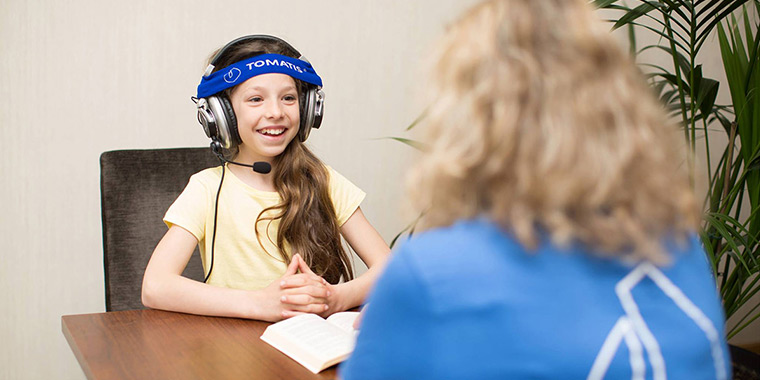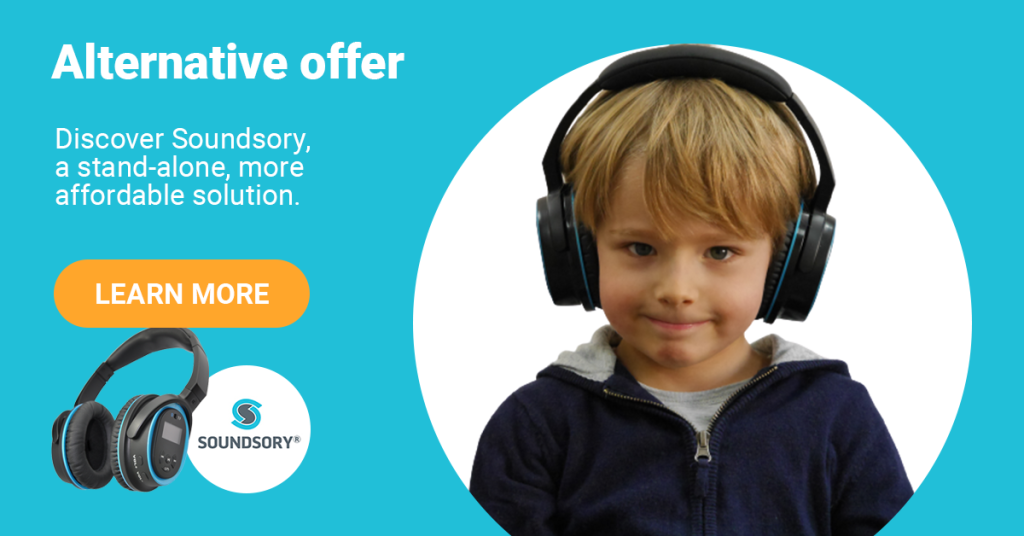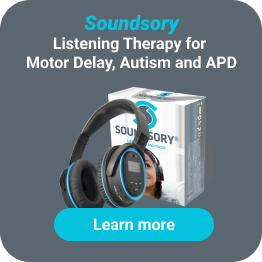The Tomatis® Method
 Valérie Leroux - October 09, 2023
Valérie Leroux - October 09, 2023 
In this article
What is the Tomatis® Method program?
Who can benefit from the Tomatis® method?
What is the historical background of the Tomatis® Method?
Which equipment is needed for the Tomatis® Method?
What is the evidence behind the Tomatis® Method?
What is the time commitment typically required for the Tomatis® Method?
Where can the Tomatis® Method be practiced?
Can the Tomatis® Method be individualised?
How much does the Tomatis® Method cost?
What are the alternatives or complementary approaches to the Tomatis® Method?
Who delivers the Tomatis® Method?
What is the Tomatis® Method (TM)?
For parents and therapists, navigating the vast array of sound therapy programs can pose a challenge when it comes to making the best choice. In this article, our primary focus lies on the Tomatis® Method, a scientifically grounded sound therapy approach designed to address auditory processing and learning challenges. In this article, we explore the components, effectiveness, pricing details and comparative analysis of the Tomatis® Method.
An intensive sound therapy program allowing for a tailored approach
The Tomatis® Method is an individualized auditory stimulation program developed by Dr. Alfred Tomatis in the 1960s. It focuses on the relationship between sound and cognitive processes to facilitate improved communication, language development, and sensory integration techniques. It is beneficial for individuals with autism spectrum disorders, attention deficit disorders, learning disabilities, speech and language delays, auditory processing disorders and sensory processing issues. Many other alternative or complementary approaches are derived from this method. In comparison to home-based treatment programs like Forbrain® or Soundsory®, which offer a user-friendly alternative, the Tomatis® Method is more professional oriented and requires an intensive time-commitment as well as the availability of certified professionals.
PROS
✅ Proprietary equipment with numerous individually tailored parameters
✅ Comprehensive professional training
✅ Intensive protocol incorporating a specialized listening test
CONS
❌ Rigorous protocol with intensive usage requirements
❌ High level of implication
What is the Tomatis® Method program?
The Tomatis® Method is an auditory stimulation program that utilizes filtered music (Mozart and Gregorian Chants) and voice feedback. It operates through a proprietary device equipped with a dynamic filter. The music and voice are transmitted via headphones using both air and bone conductions. The transmission between air and bone conduction is calibrated to create specific delays. All parameters, including filters, laterality, and transmission delays, are personalized for each individual.
As an established form of Auditory Integration Training (AIT), this method capitalizes on the principles of neuroplasticity and cognitive development to enhance listening skills and promote overall well-being. By focusing on the relationship between sound and cognitive processes, the Tomatis® Method delves into sensory stimulation, brain integration and cognitive development to facilitate improved communication, language development and sensory integration techniques. With personalized parameters and comprehensive professional training, this method ensures a tailored approach for each individual.
Who can benefit from the Tomatis® method?
The Tomatis® Method aims at benefitting individuals of all ages who face challenges in auditory processing, communication, learning and sensory integration. This Auditory Integration Training (AIT) technique taps into the principles of neuroplasticity and cognitive development, leveraging the intricate relationship between sound and cognitive processes. By incorporating sensory stimulation, brain integration, and cognitive development, the Tomatis® Method facilitates improved communication, language development, and sensory integration techniques. It proves particularly beneficial for children and adults with autism spectrum disorders (ASD), attention deficit disorders (ADHD), learning disabilities, speech and language delays, auditory processing disorders and sensory processing issues. However, its reach extends beyond these conditions, encompassing individuals seeking to enhance their listening skills, overcome communication barriers and improve overall well-being.
What is the historical background of the Tomatis® Method?
The Tomatis® Method was developed by Dr. Alfred Tomatis, a French ear, nose, and throat specialist in the 1960s. Dr. Tomatis conducted research on the relationship between the ear, the voice and the brain, exploring how the way we listen to sounds can impact our well-being and communication abilities. He suggested that inadequate or abnormal sound stimulation during pregnancy or early childhood could lead to atypical behaviors and delayed or impaired communication skills.
Dr. Alfred Tomatis initially applied his method to professional singers before expanding its application to other individuals. He introduced the concept of “auditory listening,” which involves using specific sound frequencies and patterns to stimulate the auditory system. He designed specialized equipment and protocols to deliver these sounds in a controlled manner, aiming to enhance listening skills, language development and sensory integration.
Over time, the Tomatis® Method gained recognition and attracted interest from therapists, educators, and individuals seeking alternative approaches for auditory and communication challenges. It has been implemented in various countries around the world and continues to evolve alongside ongoing research and advancements in sound therapy techniques. The company behind the Tomatis® Method is now managed by Thierry Gaujarengues and Grégoire Tomatis.
Which equipment is needed for the Tomatis® Method?
The Tomatis® equipment, known as TalksUp®, is equipped with a dynamic filter effect. Professionals configure the device settings using software. The headphones feature bone conduction on the top of the head and are also equipped with an auditory laterality setting and microphone for language tasks.
The Tomatis® Infinite headphones used in the Tomatis® Method are specially designed to provide high-quality sound transmission while incorporating specific features to ensure precise delivery of frequencies and patterns. They are typically equipped with bone conduction capability, allowing sound vibrations to reach the inner ear through the bones of the skull. Tomatis® Infinite headphones are tailored for individuals undergoing the Tomatis® Method and come with a preloaded music program that allows users to immediately experience the effects of the Tomatis® Method. These headphones also offer additional programs for consolidation and audio-vocal training, which can help strengthen and prolong the results achieved through the method. Moreover, these headphones are designed to connect seamlessly with the equipment used by Tomatis® Professionals.
The control device, connected to the headphones, enables the customization and regulation of the sound parameters according to the individual’s needs. It allows for adjusting the intensity, duration, frequency range, and modulation of the sounds being delivered.
The Soundsory® and Forbrain® equipment have been developed based on the Tomatis® Method, to allow end-users to have more options to practice at home.
What is the evidence behind the Tomatis® Method?
The scientific concept behind the Tomatis® Method is that the sound is filtered using a dynamic effect to create unpredictable sound contrasts. This effect challenges the brain, requiring it to adapt to these contrasts. The delay between sound transmission via air and bone conduction helps the brain prepare for sound analysis. By combining passive listening sessions, voice feedback sessions with a dynamic filter and bone conduction delay, the Tomatis® Method addresses all aspects of the auditory feedback loop.
Several studies have explored the potential benefits of the Tomatis® Method in specific populations and conditions. Some research suggests that the method may have positive effects on language development, auditory processing and communication skills in individuals with autism spectrum disorders, learning disabilities and speech and language delays. A recent review showed that the Tomatis® Method provides interventions that demonstrate significant improvements in autistic traits among children [1]. However, further research, particularly randomized control trials, would enhance the strength of the evidence.
What is the time commitment typically required for the Tomatis® Method?
The time commitment required for the Tomatis® Method can vary depending on several factors, including the individual’s specific goals, needs and the recommendations of the trained professionals administering the therapy. The method typically involves a series of sessions that are spread out over a period of weeks or months.
An initial 90-minute assessment, conducted through a TLTS (Tomatis® Listening Test Session), is followed by a typical Tomatis® program consisting of 1 hour and 20-minute sessions daily for 13 days. The program is then repeated three times, with breaks of 4-6 weeks between each session. The sessions involve a combination of listening to music and engaging in language tasks.
The overall duration of the Tomatis® Method program can range from several weeks to several months, depending on the individual’s progress and response to the therapy.
Where can the Tomatis® Method be practiced?
The Tomatis® Method is practiced in various locations worldwide. It is offered in specialized centers and clinics that have trained professionals knowledgeable in administering the method. These centers are typically equipped with the necessary specialized equipment required for delivering the Tomatis® Method.
The availability of Tomatis® centers may vary depending on the region or country. Larger cities or metropolitan areas often have a higher likelihood of having Tomatis® centers. It is recommended to conduct an online search specific to your location or consult with professionals in the field to identify nearby centers offering the Tomatis® Method.
In addition to physical centers, there may also be online or remote options available for accessing the Tomatis® Method. With advancements in technology, some practitioners offer remote consultations and guidance, allowing individuals to participate in the Tomatis® Method from the comfort of their own homes.
Can the Tomatis® Method be individualised?
The Tomatis® Method is known for its individualized approach. The therapy is tailored to meet the specific needs and goals of each individual. Trained professionals who administer the Tomatis® Method conduct a thorough assessment of the individual’s auditory processing, communication abilities and related challenges. This assessment helps to identify the areas that require improvement and guides the development of a personalized treatment plan.
Based on the assessment, the Tomatis® Method can be customized in terms of the specific sound frequencies, patterns, and intensities used during the therapy sessions. The trained professionals carefully select and adjust these parameters to address the individual’s unique auditory profile and target areas of improvement.
Furthermore, the duration and frequency of the therapy sessions can be adjusted according to the individual’s progress and response to the treatment. This flexibility allows for ongoing monitoring and modification of the therapy plan to optimize outcomes for each individual.
The individualized nature of the Tomatis® Method enables a tailored approach that takes into account the specific strengths, challenges, and goals of each person, ensuring a personalized and targeted therapeutic experience.
How much does the Tomatis® Method cost?
Since the Tomatis® Method is typically delivered in specialized centers by trained professionals, the cost may include various components such as the initial assessment, personalized treatment planning, therapy sessions, and follow-up evaluations. The cost structure may be influenced by the location, the number of sessions recommended and the duration of the program.
In the European Union, the approximate cost is around €500 per session, with the full individualized training course costing around €2,000, including multiple assessment tests. In the United States, when the Tomatis® Method is included as part of a treatment plan along with occupational therapy (OT) or speech-language pathology (SLP) sessions, the price can increase up to USD 5,000.

What are the alternatives or complementary approaches to the Tomatis® Method?
The Tomatis® Method offers the most intensive but also the most customizable sound therapy program. It is relatively costly compared to home-based therapies. We have listed below some alternative or complementary approaches to the Tomatis® Method, many of which are inspired or based on the Tomatis® Method:
The Therapeutic Listening® (Vital Links) Program
Therapeutic Listening®, developed by Vital Links, is a sound therapy program that draws inspiration from various methodologies including the Tomatis® Method, Auditory Integration Training (AIT) by Berard, Samonas by Steinbach, and the work of Dr. Jean Ayres. Specifically designed for individuals with autism or ADHD, this auditory program is facilitated by trained professionals. However, it is important to note that Therapeutic Listening® is not a standalone solution and should be combined with complementary sensory approaches to address the diverse needs of individuals. One such approach is the Soundsory® system, which offers a comprehensive training program incorporating sound and movement therapy. This system can be utilized in the comfort of one’s home and is a more cost-effective alternative for those seeking affordable solutions.
Therapeutic Listening® utilizes headphones and a mobile application, offering a wide range of music selections from nursery songs to classical compositions. The music is carefully filtered to emphasize specific frequencies that stimulate attention and promote body movement. Furthermore, rhythmic sound patterns are strategically incorporated to tap into the self-organizing capacities of the nervous system.
The creation of TLP also draws its inspiration from the renowned Tomatis® Method. Just like the therapeutic listening approach of Vital Links, the Listening Program® (TLP) developed by Advanced Brain Technology is a music stimulation program. TLP utilizes pre-recorded filtered sounds that are compatible with an iPod®. These sounds are derived from classical music and may also include natural sounds as an optional feature. The music provided is a recorded compilation that is divided into four progressive frequency zones.
The underlying scientific concept behind TLP is based on the idea that the brain can be divided into four regions, each of which responds to different ranges of sound frequencies. By incorporating music that progresses across the full spectrum of human sound perception, the four frequency zones aim to contribute to brain health and enhance cognitive performance.
This program requires guidance from a qualified expert to ensure its effectiveness. However, it is important to note that for a comprehensive approach tailored to individual needs, combining the Therapeutic Listening Program® with other complementary sensory approaches using movement therapy like Soundsory® is recommended.
Integrated Listening System (ILS)
The Integrated Listening System (ILS) is a program for sound therapy that utilizes a combination of pre-recorded filtered classical music and an accompanying app. One of its components is the Sound and Safe Protocol, which consists of a series of five hours of classical music that gradually undergoes filtering. The music is transmitted through regular headphones. Furthermore, ILS incorporates voice feedback tasks that necessitate the use of a specific set of headphones equipped with both air and bone conduction, along with a microphone, which are to be connected to the app.
The Integrated Listening System (ILS) encompasses various components, including the Safe and Sound Protocol, the Focus System, and the VoicePro®. These programs have become increasingly popular due to their ease of implementation and their ability to integrate auditory, language, and movement activities, which are beneficial for individuals of all ages aiming to improve their sensory capabilities. However, it is important to note that accessing these programs often requires finding a certified professional, which can be financially challenging for some individuals.
The Soundsory® program utilizes the same foundational science and principles than the Tomatis® Method but at a more affordable cost, with user-friendly equipment that can be conveniently used in the comfort of your home. It incorporates a series of movement-oriented exercises alongside meticulously crafted music subjected to neuro-acoustic processing. The primary objective of Soundsory® is to establish a firm groundwork for advancing cognitive processes, beginning with the fundamental aspects of sensory integration.
Soundsory provides dynamic and rhythmic music, including waltz and march music, specifically designed to stimulate the vestibular system. On the other hand, the Tomatis® Method primarily focuses on offering classical music as a means to support learning and language development.
Soundsory® serves as a supplementary tool to the Tomatis® Method and is widely adopted by therapists and professionals worldwide. Soundsory® employs the dynamic filter and bone conduction concept to stimulate the vestibular and auditory systems. This distinctive program combines music and movement, proving advantageous for individuals with auditory processing challenges. When used independently, the program entails a 40-day routine of 30-minute daily music listening sessions integrated with exercises. The program is split into two 20-day sessions.
Forbrain® is based on the principles of the Tomatis® Method but is aimed at end-users and can be used at home. The Forbrain® headphone incorporates innovative features such as a dynamic filter, microphone and bone conduction. By transmitting the user’s voice directly through bone structure, it improves specific vocal patterns and amplifies the voice while eliminating background noise. This unique design optimizes the auditory feedback loop by transmitting sound through bone conduction instead of traditional ear or air conduction. The recommended program duration for Forbrain® is six weeks, with daily sessions of 20 minutes.
| Tomatis® Method | Therapeutic Listening® (Vital Links) | Therapeutic Listening Program® (Advanced Brain Technologies) | |
| Purpose | Sound therapy program for auditory training | Sound therapy program for various conditions | Sound therapy program for autism and ADHD |
| Delivery Method | Delivered by certified Tomatis practitioners | Facilitated by trained professionals | Home-based program with professional guidance |
| Music Selection | Customized music based on individual needs | Wide range of music genres and styles | Over 45 album selections, 5 types of music (including classical) |
| Session Schedule | Following an initial 90-minute assessment, the process is repeated 2-3 times, with a gap of 4-6 weeks between each session. Each session lasts for 80 minutes per day over a period of 12 consecutive days. | 2 phases lasting for 1 month each. 30-minute sessions, twice a day, 7 days a week. | 2x 15 to 30-minute daily sessions, five days a week. |
| Equipment Used | Electronic ear and bone conduction devices (patented technology) | Headphones and mobile application | Headphones and specialized equipment |
| Comprehensive Approach | Addresses auditory, sensory, and motor issues | Auditory only- complementary sensory approaches recommended | Auditory only – complementary sensory approaches recommended |
| Scientific Evidence | Some scientific research supporting efficacy | Limited empirical evidence | Limited empirical evidence |
| Professional Involvement | Requires certified Tomatis practitioners | Guided by trained professionals | Professional guidance recommended |
| Integrated Listening System (ILS) | Soundsory® | Forbrain® | |
| Purpose | Sound therapy program for auditory training | Multisensory program for sensory integration | Speech and cognitive training device |
| Delivery Method | Delivered by certified ILS practitioners | Home-based program with audio and movement | Individual use at home with speech and cognitive training |
| Music Selection | Customized music based on individual needs | Music, movement, and auditory stimulation | No specific music selection (user’s voice instead) |
| Session Schedule | Typically, 2 to 5 times per week for 30 minutes. 10–20 sessions make up the program. | Two 20-day sessions of 30 minutes each, separated by a gap of 2-4 weeks, for a total of 40 days. | 20 minutes a day for a minimum of 6 weeks |
| Equipment Used | Regular headphones and specialized ILS equipment | Headphones, bone conduction microphone, and app (based on the Tomatis® patented technology) | Headset with bone conduction microphone and app ((based on the Tomatis® patented technology) |
| Comprehensive Approach | Addresses auditory, sensory, and motor issues | Multisensory integration and motor coordination | Speech and cognitive training |
| Scientific Evidence | Some scientific research supporting efficacy | Some scientific research supporting efficacy | Some scientific research supporting efficacy |
| Professional Involvement | Requires certified ILS practitioners | No professional involvement needed | No professional involvement needed |
Who delivers the Tomatis® Method?
The Tomatis® Method is typically delivered by trained professionals who have undergone specific certification or training in administering the method. These professionals may include licensed practitioners from various backgrounds such as:
- Tomatis® Method Practitioners: These are professionals who have received specialized training and certification specifically in the Tomatis® They have expertise in implementing the method and tailoring it to the individual needs of clients.
- Speech-Language Pathologists: Some speech-language pathologists incorporate the Tomatis® Method into their practice, particularly when working with individuals who have speech and language delays or auditory processing difficulties.
- Audiologists: Audiologists, who specialize in diagnosing and treating hearing-related disorders, may also offer the Tomatis® Method as part of their services. They can assess the individual’s auditory function and determine if the method is appropriate for their specific needs.
- Occupational Therapists: Occupational therapists with expertise in sensory integration may include the Tomatis® Method as part of their interventions for individuals with sensory processing challenges.
The cost and duration of the first level of certification for Tomatis live training are USD 750 for a 3-day course (equipment not included). To qualify, applicants must hold an Educational or Clinical degree and possess a minimum of 3 years of experience in a relevant field of the Tomatis® Method. Each application is assessed on a case-by-case basis. Additionally, there are four levels of certification available.
Conclusion
In conclusion, the Tomatis® Method is a listening therapy that aims to improve listening skills, communication abilities, and overall well-being. Developed by Dr. Alfred Tomatis, it utilizes filtered music and voice feedback transmitted via specialized headphones with air and bone conduction. The method capitalizes on neuroplasticity and cognitive development to enhance sensory integration, language development, and communication skills.
While it is known for its individualized approach, it is important to note that the Tomatis® Method is a time-intensive and relatively expensive commitment. There are alternative or complementary approaches available, such as Therapeutic Listening® (TL), the Listening Program (TLP), the Integrated Listening System (ILS), Soundsory®, and Forbrain®. These programs draw inspiration from the Tomatis® Method and offer different delivery methods and cost structures.
References
Brbi, I., & Tomi, L. (2020). An Integrative Review of the Effectiveness of the Tomatis Method in Children with Autism Spectrum Disorder.



